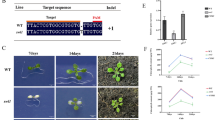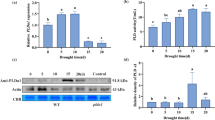Abstract
The possible role of L-ascorbate (AsA) as a biochemical signal during the interactions between photosynthesis and respiration was examined in leaf discs of Arabidopsis thaliana. AsA content was either decreased as in AsA-deficient vtc1 mutants or increased by treatment with L-galactono-1, 4-lactone (L-GalL, a precursor of AsA; EC 1.3.2.3). In mutants, photosynthesis was extremely sensitive to both antimycin A (inhibitor of the cytochrome c oxidase pathway [COX pathway]) and salicylhydroxamic acid (SHAM, inhibitor of the alternative pathway [AOX pathway]), particularly at high light conditions. Mitochondrial inhibitors lowered the ratio of reduced AsA to total AsA, at high light, indicating oxidative stress in leaf discs. Elevation of AsA by L-GalL decreased the sensitivity of photosynthesis at high light to antimycin A or SHAM, sustained photosynthesis at supraoptimal light and relieved the extent of photoinhibition. High ratios of reduced AsA to total AsA in L-GalL-treated leaf discs suggests that L-GalL lowers oxidative stress. The protection by L-GalL of photosynthesis against the mitochondrial inhibitors and photoinhibition was quite pronounced in vtc1 mutants. Our results suggest that the levels and redox state of AsA modify the pattern of modulation of photosynthesis by mitochondrial metabolism. The extent of the AOX pathway as a percentage of the total respiration in Arabidopsis mesophyll protoplasts was much higher in vtc1 than in wild type. We suggest that the role of AsA becomes pronounced at high light and/or when the AOX pathway is inhibited. While acknowledging the importance of the COX pathway, we hypothesize that AsA and the AOX pathway may complement each other to protect photosynthesis against photoinhibition.





Similar content being viewed by others
Abbreviations
- AOX:
-
alternative oxidase
- AsA:
-
ascorbate
- CCCP:
-
carbonyl cyanide m-chlorophenylhydrazone
- COX:
-
cytochrome c oxidase
- l-GalL:
-
l-galactono-1, 4-lactone
- DHA:
-
dehydroascorbate
- l-GalLDH:
-
l-galactono-1, 4-lactone dehydrogenase
- H2O2 :
-
hydrogen peroxide
- ROS:
-
reactive oxygen species
- SHAM:
-
salicylhydroxamic acid
References
Alhagdow M, Mounet F, Gilbert L, Nunes-Nesi A, Garcia V, Just D, Petit J, Beauvoit B, et al. 2007 Silencing of the mitochondrial ascorbate synthesizing enzyme L-galactono-1,4-lactone dehydrogenase affects plant and fruit development in tomato. Plant Physiol. 145 1408–1422
Bartoli CG, Pastori GM and Foyer CH 2000 Ascorbate biosynthesis in mitochondria is linked to the electron transport chain between complexes III and IV. Plant Physiol. 123 335–343
Bartoli CG, Gomez F, Gergoff G, Guiame´t JJ and Puntarulo S 2005 Up-regulation of the mitochondrial alternative oxidase pathway enhances photosynthetic electron transport under drought conditions. J. Exp. Bot. 56 1269–1276
Bartoli CG, Yu JB, Gomez F, Fernandez L, McIntosh L and Foyer CH 2006 Inter-relationship between light and respiration in the control of ascorbic acid synthesis and accumulation in Arabidopsis thaliana leaves. J. Exp. Bot. 57 1621–1631
Cornic G, Bukhov NG, Wiese C, Bligny R and Heber U 2000 Flexible coupling between light-dependent electron and vectorial proton transport in illuminated leaves of C3 plants. Role of photosystem I-dependent proton pumping. Planta 210 468–477
Endo T, Shikanai T, Sato F and Asada K 1998 NAD(P)H dehydrogenase dependent, antimycin A-sensitive electron donation to plastoquinone in tobacco chloroplasts. Plant Cell Physiol. 39 1226–1231
Foyer CH and Noctor G 2000 Oxygen processing in photosynthesis: regulation and signalling. New Phytol. 146 359–388
Foyer CH and Noctor G 2003 Redox sensing and signalling associated with reactive oxygen in chloroplasts, peroxisomes and mitochondria. Physiol. Plant. 119 355–364
Foyer CH, Rowell J and Walker D 1983 Measurement of the ascorbate content of spinach leaf protoplasts and chloroplasts during illumination. Planta 157 239–244
Gardeström P, Igamberdiev AU and RaghavendraA S 2002 Mitochondrial functions in light; in Photosynthetic nitrogen assimilation and associated carbon and respiratory metabolism (eds) CH Foyer and G Noctor (Dordrecht: Kluwer Academic Publishers) pp 151–172
Gatzek S, Wheeler G L and Smirnoff N 2002 Antisense suppression of L-galactose dehydrogenase in Arabidopsis thaliana provides evidence for its role in ascorbate synthesis and reveals light modulated L-galactose synthesis. Plant J. 30 541–553
Giacomelli L, Masi A, Ripoll RLee M and Wijk KJ 2007 Arabidopsis thaliana deficient in two chloroplast ascorbate peroxidases shows accelerated light induced necrosis when levels of cellular ascorbate are low. Plant Mol. Biol. 165 627–644
Guy, R.D., and G.C. Vanlerberghe. 2005. Partitioning of respiratory electrons in the dark in leaves of transgenic tobacco with modified levels of alternative oxidase. Physiol. Plantarum 125 171–180
Halliwell B and Foyer CH 1976 Ascorbic acid, metal ions and the superoxide radical. Biochem. J. 155 697–700
Huang C, He W, Guo J, Chang, X, Su P and Zhang L 2005 Increased sensitivity to salt stress in an ascorbate-deficient Arabidopsis mutant. J. Exp. Bot. 422 3041–3049
Klotz KL, Finger FL and Anderson MD 2008 Respiration in postharvest sugarbeet roots is not limited by respiratory capacity or adenylates. J. Plant Physiol. 165 1500–1510
Mano J, Hideg E and Asada K 2004 Ascorbate in thylakoid lumen functions as an alternative electron donar to photosystem II and I. Arch. Biochem. Biophys. 429 71–80
Maxwell DP, Wang Y and Lee M I 1999 The alternative oxidase lowers mitochondrial reactive oxygen production in plant cells. Proc. Natl. Acad. Sci. USA 96 8271–8276
Millar AH, Mittova V, Kiddle G, Heazlewood JL, Bartoli CG, Theodoulou FL and Foyer CH 2003 Control of ascorbate synthesis by respiration and its implications for stress responses. Plant Physiol. 133 443–447
Moller IM, Bkrczi A, Linus HW, Plas V and Lambers H 1988 Measurement of the activity and capacity of the alternative pathway in intact plant tissues: Identification of problems and possible solutions. Physiol. Plant. 72 642–454.
Müller-Moulé P, Havaux M and Niyogi KK 2003 Zeaxanthin deficiency enhances the high light sensitivity of an ascorbate-deficient mutant of Arabidopsis. Plant Physiol. 133 748–760
Müller-Moulé P, Golan T and Niyogi KK 2004 Ascorbate-deficient mutants of Arabidopsis grow in high light despite chronic photoxidative stress. Plant Physiol. 134 1163–1172
Noctor G, De Paepe R and Foyer CH 2007 Mitochondrial redox biology and homeostasis in plants. Trends Plant Sci. 12 125–134
Nunes-Nesi A, Carrari F, Lytovchenko A, Smith AMO, Loureiro ME, Ratcliffe RG, Sweetlove LJ and Fernie AR 2005 Enhanced photosynthetic performance and growth as a consequence of decreasing mitochondrial malate dehydrogenase activity in transgenic tomato plants. Plant Physiol. 137 611–622
Nunes-Nesi A, Sulpice RR, Gibon Y and Fernie AR 2008 The enigmatic contribution of mitochondrial function in photosynthesis. J. Exp. Bot. 59 1675–1684
Padmasree K and Raghavendra AS 1999 Consequence of restricted mitochondrial oxidative metabolism on photosynthetic carbon assimilation in mesophyll protoplasts: Decrease in light activation of four chloroplastic enzymes. Physiol. Plant. 112 582–588
Padmasree K and Raghavendra AS 2001 Restriction of mitochondrial oxidative metabolism leads to suppression of photosynthetic carbon assimilation but not of photochemical electron transport in pea mesophyll protoplasts. Curr. Sci. 81 680–684
Padmasree K, Padmavathi L and Raghavendra AS 2002 Essentiality of mitochondrial oxidative metabolism for photosynthesis: optimization of carbon assimilation and protection against photoinhibition. Crit. Rev. Biochem. Mol. Biol. 37 71–119
Pignocchi C and Foyer CH 2003 Apoplastic ascorbate metabolism and its role in the regulation of cell signalling. Curr. Opin. Plant Biol. 6 379–389
Pineau B, Layoune O, Danon A and De Paepe R 2008 L-galactono-1, 4-lactone dehydrogenase is required for the accumulation of plant respiratory complex I. J. Biol. Chem. 283 32500–32505
Raghavendra AS and Padmasree K 2003 Beneficial interactions of mitochondrial metabolism with photosynthetic carbon assimilation. Trends Plant Sci. 8 546–553
Riazunnisa K, Padmavathi L, Schiebe R and Raghavendra AS 2007 Preparation of Arabidopsis mesophyll protoplasts with high rates of photosynthesis. Physiol. Plant. 129 679–686
Robson CA and Vanlerberghe GC 2002 Transgenic plant cells lacking mitochondrial alternative oxidase have increased susceptibility to mitochondria- dependent and independent pathways of programmed cell death. Plant Physiol. 129 1908–1920
Schacter B and Bassham JA 1972 Antimycin A sensitive stimulation of rate-limiting steps of photosynthesis in isolated spinach chloroplasts. Plant Physiol. 49 411–416
Smirnoff N 2000 Ascorbic acid: metabolism and functions of a multi-facetted molecule. Curr. Opin. Plant Biol. 3 229–235
Smirnoff N, Conklin PL and Loewus FA 2001 Biosynthesis of ascorbic acid in plants: A renaissance. Annu. Rev. Plant Physiol. Plant Mol. Biol. 52 437–467
Somerville CR and Ogren WL 1982 Isolation of photorespiration mutants in Arabidopsis thaliana; in Methods in chloroplast biology (eds) M Edelman, RB Hallick and NH Chua (Amsterdam: Elsevier Biomedical Press) pp 129–138
Tambussi EA, Bartoli CG, Beltrano J, Guiamet JJ and Araus JL 2000 Oxidative damage to thylakoid proteins in water-stressed leaves of wheat (Triticum aestivum). Physiol. Plant. 108 398–404
Veljovic-Jovanovic SD, Pignocchi C, Noctor G and Foyer CH 2001 Low ascorbic acid in the vtc1 mutant of Arabidopsis is associated with decreased growth and intracellular redistribution of the antioxidant system. Plant Physiol. 127 426–435
Vidal G, Carbo MR, Garmier M, Dubertret G, Rasmusson AG, Mathieu C, Foyer CH and Paepe R D 2007 Lack of respiratory chain complex I impairs alternative oxidase engagement and modulates redox signalling during elicitor-induced cell death in tobacco. Plant Cell 19 640–655
Walker D 1988 The Use of the oxygen electrode and fluorescence probes in simple measurements of photosynthesis (University of Sheffield Press)
Yabuta Y, Mieda T, Madhusudhan R, Ayana N, Motoki T, Maruta T, Yoshimura K, Ishikawa T and Shigeoka S 2007 Light regulation of ascorbate biosynthesis is dependent on the photosynthetic electron transport chain but independent of sugars in Arabidopsis. J. Exp Bot. 5 2661–2671
Yoshida K, Terashima I and Noguchi K 2006 Distinct roles of the cytochrome pathway and alternative oxidase in leaf photosynthesis. Plant Cell Physiol. 47 22–31
Yoshida K, Terashima I and Noguchi K 2007 Up-Regulation of mitochondrial alternative oxidase concomitant with chloroplast over-reduction by excess light. Plant Cell Physiol. 48 606–614
Acknowledgements
This work was supported by grants to ASR from Council of Scientific and Industrial Research (No. 38(1063)/03/EMR), and a JC Bose National Fellowship (No. SR/S2/JCB-06/2006). Senior Research fellowships from CSIR to KR and LP, University Grants Commission-Special Assistance Program fellowship for meritorious students to (TSK and BS) and Junior Research fellowship from UGC (PR). Special grants from the Department of Science and Technology (DST-FIST) and University Grants Commission (UGC-SAP–CAS-I) were provided to the Department of Plant Sciences. We thank Dr Nick Smirnoff for providing us with an initial supply of seeds of wild-type and vtc1 mutant of A. thaliana and also a small sample of L-galactono-1,4-lactone.
Author information
Authors and Affiliations
Corresponding author
Additional information
Corresponding editor: Jitendra P Khurana
[Talla S, Riazunnisa K, Padmavathi L, Sunil B, Rajsheel P and Raghavendra AS 2011 Ascorbic acid is a key participant during the interactions between chloroplasts and mitochondria to optimize photosynthesis and protect against photoinhibition. J. Biosci. 36 XXX–XXX] DOI
Rights and permissions
About this article
Cite this article
Talla, S., Riazunnisa, K., Padmavathi, L. et al. Ascorbic acid is a key participant during the interactions between chloroplasts and mitochondria to optimize photosynthesis and protect against photoinhibition. J Biosci 36, 163–173 (2011). https://doi.org/10.1007/s12038-011-9000-x
Published:
Issue Date:
DOI: https://doi.org/10.1007/s12038-011-9000-x




